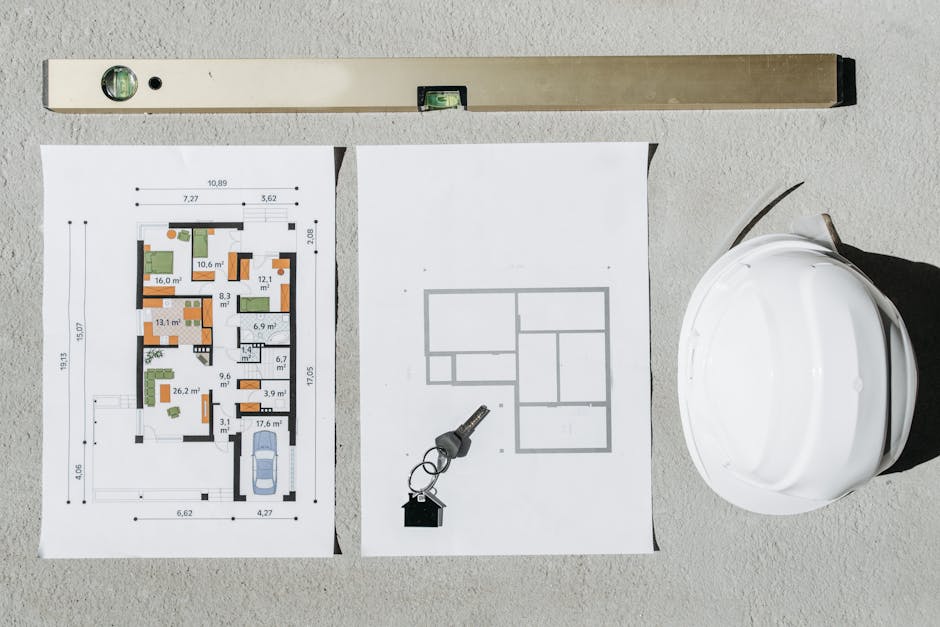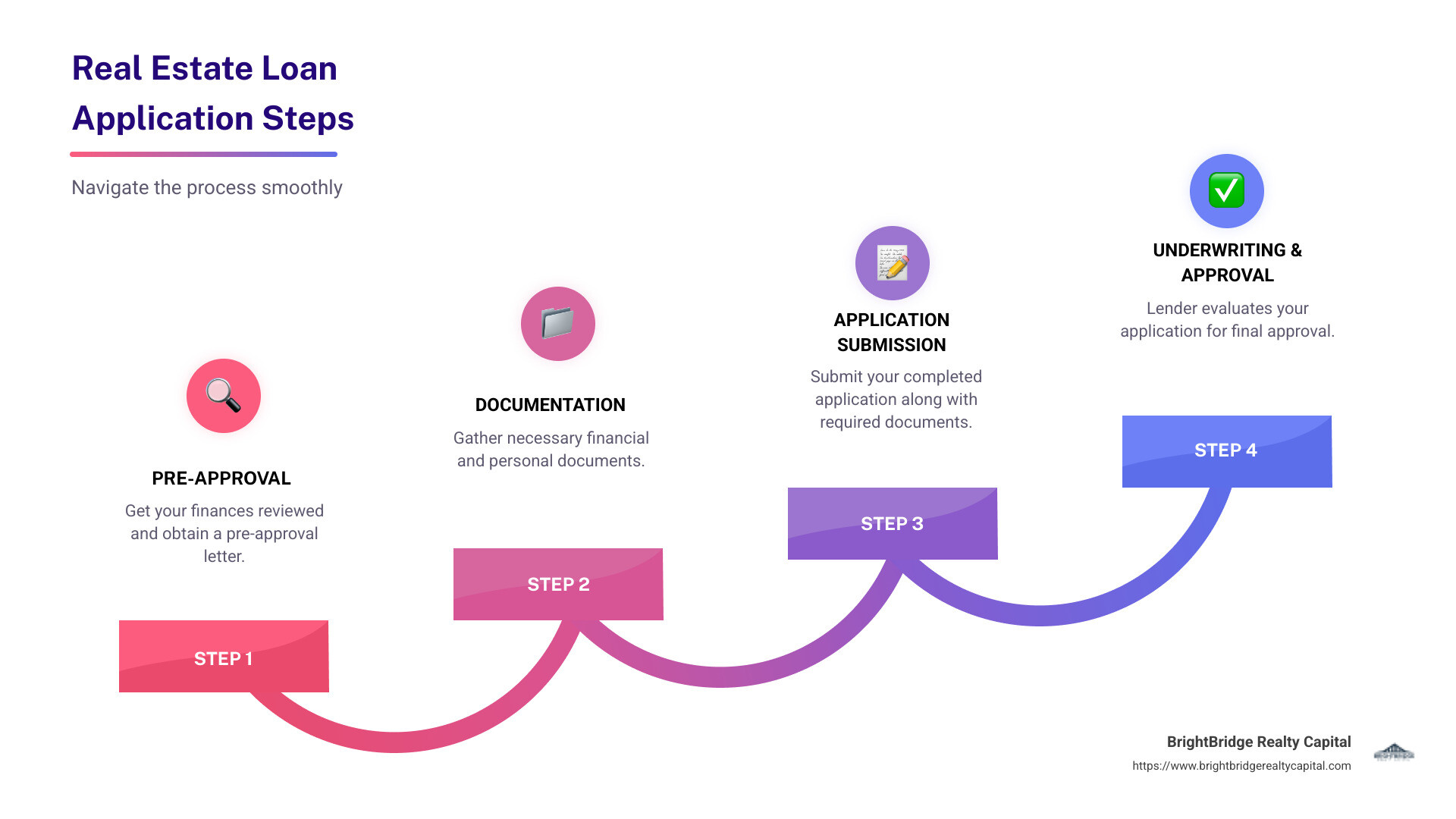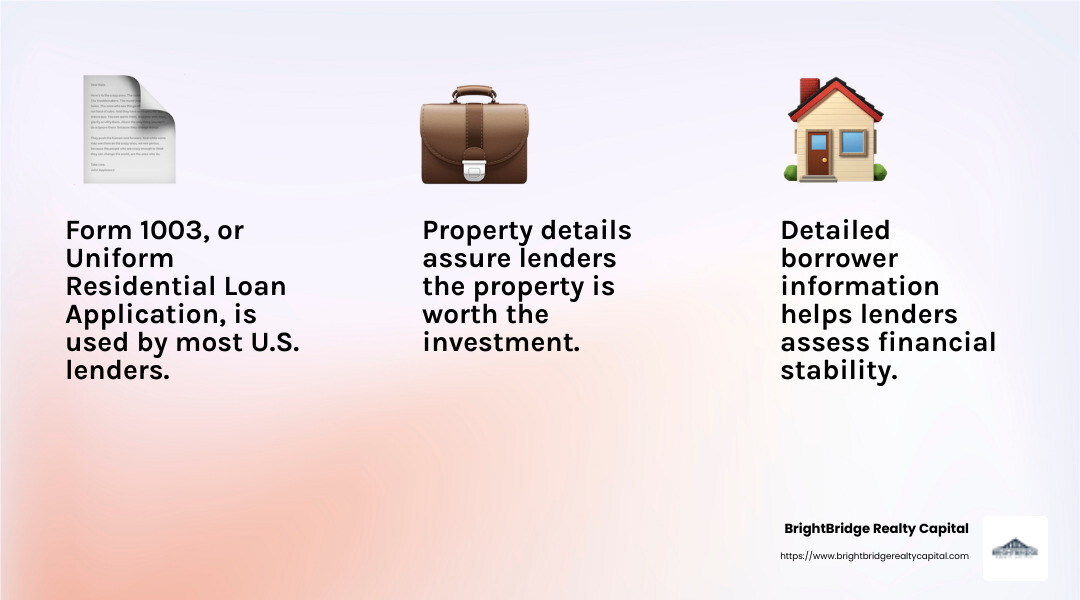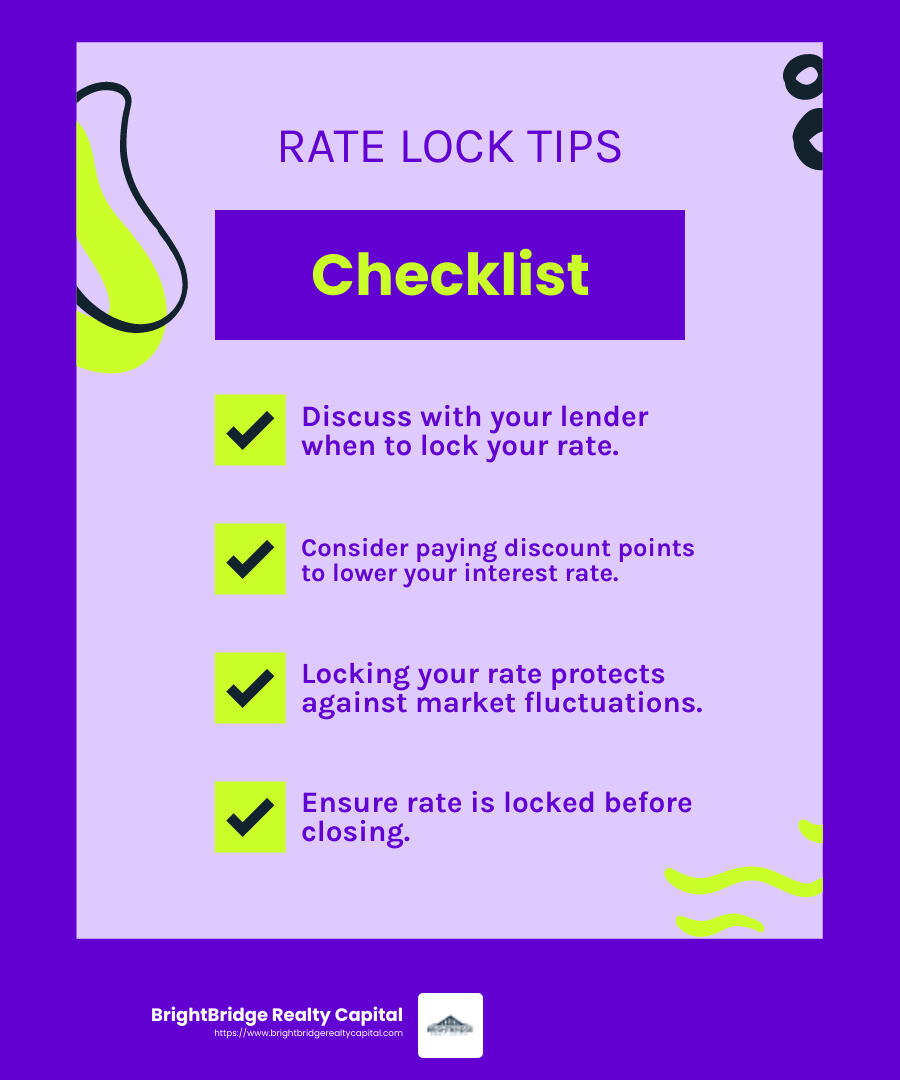Loan Application 101: Building Your Real Estate Dreams

Real estate loan application is your gateway to building and expanding your property dreams. Whether you're stepping into fix-and-flip projects or broadening your rental portfolio, understanding this crucial step can open doors to countless opportunities.
Quick Overview of a Real Estate Loan Application:
- Purpose: Provides the financial support needed for purchasing, improving, or refinancing real estate.
- Process Involvement: Includes pre-approval, detailed documentation, and a lender's thorough evaluation.
- Essential Components: Your credit score, debt-to-income ratio, and a comprehensive financial snapshot.
In this guide, we'll explain the real estate loan application process, making it accessible and manageable for both seasoned investors and newcomers. Expect insights into the essential documents, understanding Form 1003, and the step-by-step journey from application to approval.

Real estate loan application terms to learn:
- construction loan documentation
- construction loan approval process
- construction loan credit requirements
Understanding the Real Estate Loan Application
Key Components of a Real Estate Loan Application
When diving into the real estate loan application process, understanding its key components is essential. This knowledge not only prepares you for what lies ahead but also empowers you to present a strong case to lenders.
Mortgage Application: The Foundation
At the heart of the process is the mortgage application. This document is your formal request to a lender for a loan to purchase real estate. It includes a treasure trove of information about you and the property you wish to buy.
One of the most common forms used is the Form 1003, also known as the Uniform Residential Loan Application. This standardized form is used by most lenders across the U.S. and provides a comprehensive overview of your financial health and the property details.
Borrower Information: The Personal Touch
Lenders need to know who they're dealing with. This means providing detailed borrower information. Expect to share:
- Personal Details: Your address, marital status, and Social Security number.
- Employment History: Current and past employment details, including your employer's name and address.
- Income Verification: Pay stubs, W-2s, or, if self-employed, tax returns for the past two years.
These details help lenders assess your financial stability and reliability as a borrower.
Financial Situation: The Big Picture
Your financial situation is a critical piece of the puzzle. Lenders want a clear picture of your assets, liabilities, and overall financial health.
- Assets: Include bank accounts, retirement savings, and brokerage accounts.
- Liabilities: Cover debts like credit cards, student loans, and any other financial obligations.
Understanding your debt-to-income ratio is crucial here. It helps lenders gauge your ability to manage additional debt.
Property Details: The Investment
Finally, the property itself plays a significant role in the application process. This section requires:
- Property Information: Details about the home you want to purchase.
- Estimated Value: Appraisals or comparable sales in the area.
- Rental Income: If applicable, any income the property might generate.
These details assure lenders that the property is worth the investment and can cover the loan amount if needed.

By understanding these key components, you're better equipped to steer the real estate loan application process confidently. Thorough preparation and transparency can significantly improve your chances of approval.
Steps to Apply for a Real Estate Loan
Starting on the path to securing a real estate loan can seem daunting, but breaking it down into manageable steps makes it easier. Let's explore the essentials of gathering documents and submitting your application.
Gathering Necessary Documents
Before you even think about submitting a real estate loan application, preparation is key. Start by collecting the necessary documents that lenders will require:
W-2s and Pay Stubs: These documents provide proof of your income. Typically, you'll need two years of W-2s and recent pay stubs to verify your employment and income consistency.
Bank Statements: Lenders want to see your financial stability. Provide statements from your savings, checking, and any investment accounts. This helps them understand your financial habits and available assets.
Tax Returns: If you're self-employed, tax returns for the past two years are essential. They offer a comprehensive view of your income and financial health.
Having these documents ready speeds up the application process and gives lenders confidence in your financial reliability.
Submitting Your Application
Once your documents are in order, you're ready to submit your real estate loan application. Here's how to proceed:
Pre-Approval:
- Before diving into the full application, seek pre-approval from your lender. This step gives you a clear idea of how much you can borrow and strengthens your position as a buyer.
- Pre-approval involves a soft credit check and a preliminary review of your financial situation. This won't affect your credit score but helps set realistic expectations.
Loan Estimate:
- After pre-approval, request a loan estimate from multiple lenders. This document outlines the terms of the loan, including interest rates and closing costs.
- Compare these estimates to find the best deal. Lenders are required to provide this within three business days of receiving your application.
Online Application:
- Many lenders offer online application portals for convenience. This method allows you to upload documents and track your application status easily.
Lender Requirements:
- Each lender may have specific requirements. Be ready to provide any additional information they request, such as explanations for credit inquiries or large deposits.
Credit Check:
- A hard credit check will be performed as part of the application process. Ensure your credit report is accurate and address any discrepancies beforehand.
By following these steps, you'll be well on your way to securing a real estate loan and turning your property dreams into reality. Next, we'll explore how to steer the mortgage process, including locking in your interest rate.
Navigating the Mortgage Process
Locking in Your Interest Rate
Once you've submitted your real estate loan application, it's time to steer the mortgage process. This involves several key steps: pre-approval, underwriting, and closing. But one crucial aspect to focus on is locking in your interest rate.
Pre-Approval
Pre-approval is a vital first step. It gives you a strong footing by showing sellers that you are a serious buyer. During pre-approval, lenders assess your financial situation, often conducting a soft credit check. This step helps you understand how much you can borrow, setting realistic expectations.
Underwriting
Underwriting is where the magic happens. It's the behind-the-scenes process where underwriters verify all the information you've provided. They check your credit history, employment, and financial documents to ensure you meet the loan criteria.
Underwriters also order an appraisal to determine the property's value. This ensures the loan amount aligns with the property's worth. Once underwriting is complete, you'll receive a decision: approval, denial, or approval with conditions.
Locking in Your Interest Rate
Interest rates can fluctuate daily, so locking in your rate is a smart move. A rate lock guarantees your interest rate for a specified period, protecting you from potential increases.
How to Lock Your Rate: Discuss with your lender when to lock your rate. If you believe rates might rise, locking in early can save you money. If you think they'll fall, you might wait. It's a personal decision, but remember, the rate must be locked before closing.
Discount Points: Consider discount points to lower your interest rate. Paying points upfront can reduce your monthly payments over the loan's life. It's an upfront cost but can lead to long-term savings.

Closing
Finally, closing is the last step. This is when you'll sign the final documents, pay closing costs, and officially receive the keys to your new property.
During closing, review the closing disclosure form carefully. It should match the loan estimate you received earlier. If there are discrepancies, address them immediately.
Navigating the mortgage process can seem complex, but understanding each step makes it manageable. By securing your interest rate and preparing for underwriting and closing, you're well on your way to achieving your real estate dreams.
Next, we'll tackle some frequently asked questions about real estate loan applications to further ease your journey.
Frequently Asked Questions about Real Estate Loan Applications
What is a Real Estate Loan Application?
A real estate loan application is a detailed document you submit to a lender when you want to buy a property. It includes important information about you, such as your employment history, financial situation, and details about the property you want to purchase. Lenders use this information to decide if they will approve your loan.
The most common form for this application in the U.S. is the Form 1003, also known as the Uniform Residential Loan Application. This form helps lenders assess whether you are a good candidate for a loan.
How Does Credit Score Affect My Application?
Your credit score plays a big role in your loan application. It affects the interest rate you get and whether you qualify for certain types of loans. A higher credit score usually means a lower interest rate, which can save you money over time.
If your credit score is lower, you might still qualify for a loan, but the interest rate could be higher. Some loans, like FHA loans, are more forgiving for those with lower credit scores. They offer low down payment options and are designed to help first-time homebuyers.
What Documents Are Required for a Real Estate Loan Application?
To complete your mortgage application, you'll need to gather several important documents. These include:
Financial Documents: You'll need to provide recent pay stubs, W-2s, and bank statements. These documents help lenders verify your income and financial stability.
Employment Verification: Lenders want to know you have a steady job. You may need to provide contact information for your employer or recent tax returns if you're self-employed.
Property Information: Details about the property you're buying are crucial. This includes the purchase agreement and any appraisals or inspections that have been done.
Having all these documents ready can speed up the approval process and help you secure your dream home faster.
Next, we'll explore more about the closing process and how to ensure a seamless experience with BrightBridge Realty Capital.
Conclusion
At BrightBridge Realty Capital, we know that securing a real estate loan can seem daunting. But it doesn't have to be. Our mission is to make the process as smooth and efficient as possible for you.
Fast Closings: One of our standout features is our ability to close loans quickly. Often, we can finalize your loan within a week. This speed allows you to seize opportunities in the competitive real estate market without delay.
Seamless Process: From your initial inquiry to the final payoff, we manage every detail in-house. This means no intermediaries, fewer problems, and a more straightforward experience for you. Our team of experts is here to guide you every step of the way, ensuring that your journey to real estate ownership is as hassle-free as possible.
We take pride in offering competitive rates and flexible funding solutions custom to your needs. Whether you're flipping a property, building from the ground up, or expanding your rental portfolio, we provide the support and resources you need to succeed.
Ready to take the next step in your real estate journey? Explore our services to see how we can help you build your real estate dreams.


